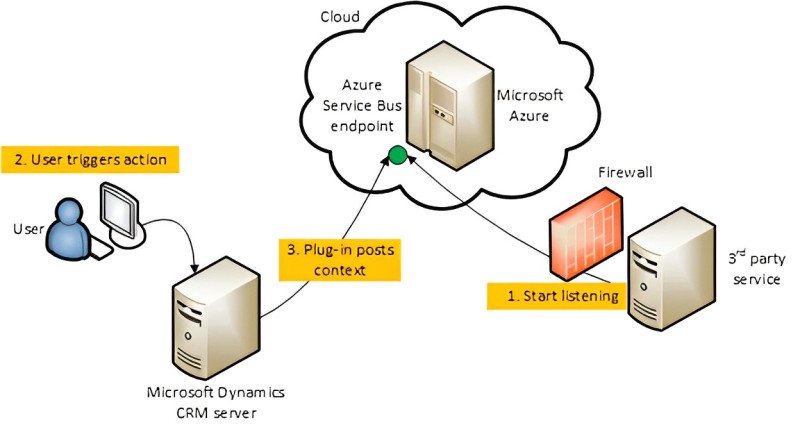Looking to Infuse Your CRM with Intelligence? Here is a 5-step Guide to Integrating Dynamics 365 and Azure AI
As customer data volumes explode, manual processes struggle to keep pace. Dynamics 365 provides database-level intelligence, but integrating next-level Azure AI unlocks more advanced automation and insights.
So how can you make your Microsoft Dynamics CRM Services smarter and take a proactive approach to engaging customers?

Follow this 5-step blueprint for Integrate Dynamics 365 CRM with Azure AI
Step 1: Plan Your AI Strategy and Start Small
Kicking off any new project without good planning usually ends badly. The same applies double when introducing sophisticated technologies like artificial intelligence (AI) across business systems.
Things get complex quickly if not thoughtful upfront about what specifically you want to achieve.
Begin by narrowly defining a couple of high-value problems needing solutions – manual processes dragging down payroll costs or customers annoyed answering the same basic questions repeatedly.
Resist the temptation to boil the ocean starting, which only creates confusion down the line about what is trying to get accomplished.
Gather a small interdisciplinary team to decide whether AI can reasonably address the issues identified above.
Technical architects, business analysts, and department heads representing areas impacted – even frontline workers doing the activities today if possible. The broader lens will highlight considerations easy to miss in a vacuum.
Map out an initial pilot idea addressing the problems, including specific AI methods worth exploring, data and permissions needed to fuel solutions, key milestones with timing, and measures for success tracking ROI. Establish team member roles and rough budgets associated with pursuing ideas further.
For example, deflecting common customer service questions to save human hours. The approach might leverage natural language AI chatbots instead of forcing customers through clumsy phone trees.
Data required would be logs of frequent recurring questions and acceptable responses.
Key milestones would be not correctly addressing the 5 most frequent questions with scores for response accuracy, and customer satisfaction relative to status quo.
The budget would cover software, implementation services, and testing. Socialize proposals with executives to secure buy-in on pursuing ideas further.
Quantify the expected impact of solving original issues in terms anyone can understand – hours saved, reduced costs, revenue gained, improved customer retention, etc.
Make a case for why AI specifically is needed now more than ever based on trends across the industry.
With the green light confirmed, the same pilot team now oversees the actual design and testing of proposed solutions. Partnering with a leading Generative AI Development Company can empower organizations to harness AI’s potential fully. This collaboration can accelerate design iterations, improve testing accuracy, and ensure solutions are not only effective but also adaptable to future needs and challenges.
Maintain focus on addressing original problems, and resist feature creep early that complicates instead of simplifies.
Be hyper focused measuring performance against success criteria established earlier.
How well does AI address the pain points? Where might be falling short? Capture feedback from real users exposed to functionality for enhancement considerations.
Step 2: Collect Quality Data and Map Processes
Irrespective of which fancy algorithms get applied, artificial intelligence solutions rely on quality information fueling analysis for reliable outcomes.
Much like how a fancy race car can’t run far with bad gasoline. Begin by taking inventory of available data within your company and systematically assessing fitness.
Start with core customer information – names, contact info, transaction history, support interactions, product registrations, and online browsing trails.
Connect files currently fragmented across various business systems into a master database using ETL tools like SSIS.
Remove duplicate records, fill gaps with missing values, and verify the integrity of key fields teams rely on like timestamps properly formatted.
The consolidating work is tedious but prevents misleading AI conclusions later drawing from mismatched data pools.
Plus it serves as a backbone enabling future expansion to incorporate emerging information streams as they surface.
Understand exactly how cross-functional teams currently leverage information by mapping end-to-end processes and activities that rely on data. Detail-specific hand-off points between sales, marketing, finance, and operations.
Note areas are still driven via manual spreadsheets or reports prone to automation opportunities.
Clarify not just what analysis gets produced but how outputs subsequently drive real-world decisions and tasks.
The document knows existing data pain points as well – collections with inconsistent tax ID formats prohibiting consolidation, untracked data sources providing inputs for key projections, and latency of updates between systems impacting real-time operations.
Facts are needed but hard to obtain. Gut checks rely on the tribal knowledge of tenured personnel. Capture it all.
Such clarity around upstream dependencies, downstream decisions, and overall environment holistically is crucial.
Ensures AI is trained to mirror real-world complexities as much as possible, not Oversimplified views divorced from reality.
Plus it highlights a combination of technologies required – data warehousing, ETL, master data management – beyond just AI components alone.
Think crawl, walk, and run. Better to lay proper foundations early rather than take shortcuts that turn into dead ends halfway through implementation!
Step 3: Staff Key Roles to Guide AI Efforts
Given the data’s readiness for deeper analysis and baselining of current process flows, the next step is assembling talent across key roles shepherding AI from ideation to real-world implementation:
AI Portfolio Manager – Owns overall technology vision and roadmap. Vets new project proposals from departments and conducts cost-benefit analysis before green-lighting investment.
Sets budgets, forecasts ROI secures executive support. Leads special interest committees from IT, analytics, and operations evaluating ongoing efforts and resolving issues.
Data Architects & Engineers – Ingest quality data powering AI through pipelines and databases like Azure Synapse.
Enforce strong data governance practices meeting compliance and ethics standards around access, retention, and consent. Promote discovery and self-service access.
Model Trainers – Develop intelligent algorithms leveraging Azure Machine Learning across deep learning, computer vision, reinforcement learning, natural language processing, and other techniques.
Follow defined model development lifecycles. Properly document model logic, performance metrics, and ownership.
Functional Leads – Help design future business workflows and change management plans leveraging AI.
Ensure solutions enhance rather than hinder roles across sales, marketing, and finance. Serve as pilot users before broad capability release.
Covering the full gamut of roles increases the probability of landing AI safely and effectively into business instead of siloed proofs of concept stagnating in labs.
Sufficient oversight also allows taking measured risks, knowing help is available if hit by unexpected turbulence. Stay vigilant filling any skill gaps early!
Step 4: Build Quick-Win AI Capabilities
With the groundwork set, it’s time to start realizing some quick wins by applying AI to common pain points companies face daily – repetitive manual tasks, frequently asked customer questions and unpredictable workflow volumes.
A few prime opportunities well suited for early automation powered by Azure Cloud Migration Services:
1. Customer Service Deflection with Chatbots
High call volumes overwhelm agents leading to long hold times and frustrated callers.
Intelligent virtual assistants can deflect common repetitive questions to self-service pathways quickly while still routing complex issues to people seamlessly.
Using Azure tools like QnA Maker, LUIS, and Bot Framework, quickly build a helper chatbot handling 5-10 basic questions for a department.
Make sure it understands context, redirects new questions it can’t answer to agents, and continues improving answers via ongoing human feedback.
The bot scales dynamically so no callers wait on hold, providing 24/7 assistance with callbacks during business hours if needed.
Meanwhile, agents focus on trickier technical cases instead of repeating the same steps like password resets or payment confirmations all day.
2. Predictive Lead Scoring
Sales wasting time cold calling any prospects is frustrating and ineffective. Wouldn’t it be smarter if they could focus calls on the warmest highest-quality leads first?
Build a basic lead scoring model using past customer data, looking at traits of those who converted compared to those who did not.
Company size, industry, downloaded content assets, email engagement history, etc all provide signals.
Establish point thresholds automatically triggering outreach at just the right moment.
Now sales conversations become far more productive, converting more blossoming opportunities into closed deals. Confidently phase out cold calling completely.
3. Personalized Cross-sell & Upsell Recommendations
Suggesting random products usually leads customers to ignore offers entirely.
Providing recommendations tailored specifically to individual shopper preferences and histories performs far better.
Leverage collaborative filtering algorithms to uncover what item pairings existing loyal buyers frequently purchase together.
Identify distinct customer segments exhibiting similar behaviors using clustering methods.
Develop a simple recommendation engine exposing agents and online shoppers to the most relevant offers aligned to past behaviors.
Conversions on recommendations skyrocket thanks to hyper-personalization, leading to bigger basket sizes and happier repeat customers.
The same technology powers Amazon and Netflix’s suggestion engines driving billions in sales.
The key is focusing AI implementation on problems with straightforward solutions offering quick productivity lifts, cost savings, or revenue gains right away.
Choosing narrow high-impact use cases builds confidence across the organization faster spurring the appetite for applying AI more boldly over time.
Step 5: Monitor, Maintain, and Expand AI Maturity
Like any technology, AI solutions need ongoing care and feeding, maintaining accuracy as the world changes around models’ creation.
Don’t “set and forget” after the initial rollout or face degraded performance over time. Actively monitor, update, and expand capabilities to hit fresh pain points emerging daily across the business landscape.
Rigorously measure key indicators allowing early detection of deteriorating AI quality from the original baseline:
- Prediction accuracy rates on intents, classifications, forecasts
- Automated task completion percentages
- Customer satisfaction scores
- Revenue influence metrics
Set alerts on dropping thresholds automatically notifying technical teams to dig deeper into root causes.
Is an algorithm’s logic still sound or are real-world changes rendering assumptions invalid?
Do certain market segments, geographies or customer types need dedicated models accounting for unique quirks?
Expand training dataset diversity continuously, capturing edge cases early to further bolster precision.
Cycle different techniques evaluating their lift – neural networks, logistic regression, and random forest classifiers. No single winner fits all needs universally.
Catalog existing models with Model Manager and Data Manager capturing critical operational metadata – creation dates, ownership, data dependencies, and business logic explaining predictions.
Accelerate troubleshooting and modifications keeping all knowledge in one place.
Over time identify fresh scenarios benefiting from intelligence injection to continue automating business processes.
Re-assess end-to-end workflows and data pipeline improvements unlocking greater efficiency at scale.
The key is instilling maintenance rigor early in AI lifecycles, not playing catch up after half-forgotten models are mysteriously misfiring creating headaches for multiple departments counting on reliability.
As models continue maturing, also implement strong model risk management practices ensuring AI decisions avoid unfair bias while maintaining compliance with industry regulations.
Establish review checkpoints at different stages of development lifecycles before new models get deployed.
Design stage – Assess data sources powering algorithms for quality, breadth, and balanced representation minimizing bias risks.
Clearly define target variables predicted and success metrics aligned to business objectives – what constitutes a “good” vs. “bad” outcome?
Build & Train stage – Inspect features heavily weighted interpreting correlations.
Tune decision thresholds, calibrate confidence intervals, and run what-if simulations checking for skews disadvantaged certain customer segments more than others.
Pre-deployment stage – Score holdout evaluation datasets checking for unfair outcomes, manipulating inputs probing for susceptibility, and comparing multiple models’ pros and cons.
Establish ongoing monitoring thresholds and have rollback procedures ready.
Production stage – Continually check for prediction drift indicating potential data or logic decay. Re-validate with the latest real-time data.
Maintain responsible AI checklists addressing transparency, auditability, bias detection, and recourse procedures.
By ingraining ethical AI practices, companies avoid reputation erosion associated with problematic models unfairly profiling certain demographics in the pursuit of efficiency.
Responsible AI builds durable competitive advantage with customers feeling protected and empowered by technology working for rather than against them.
The diligent work compounds exponentially over time. Approached deliberately, infusing AI unlocks immense potential from Dynamics 365 investments already made.
What lessons have you learned navigating the intelligent CRM path? Please share your thoughts below.



